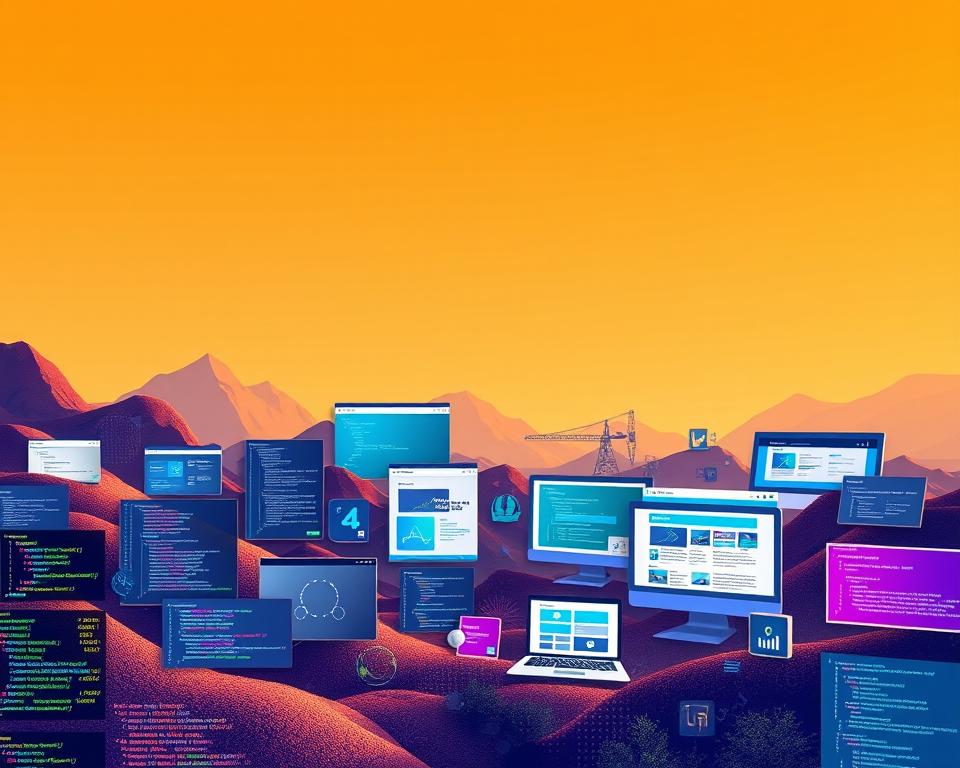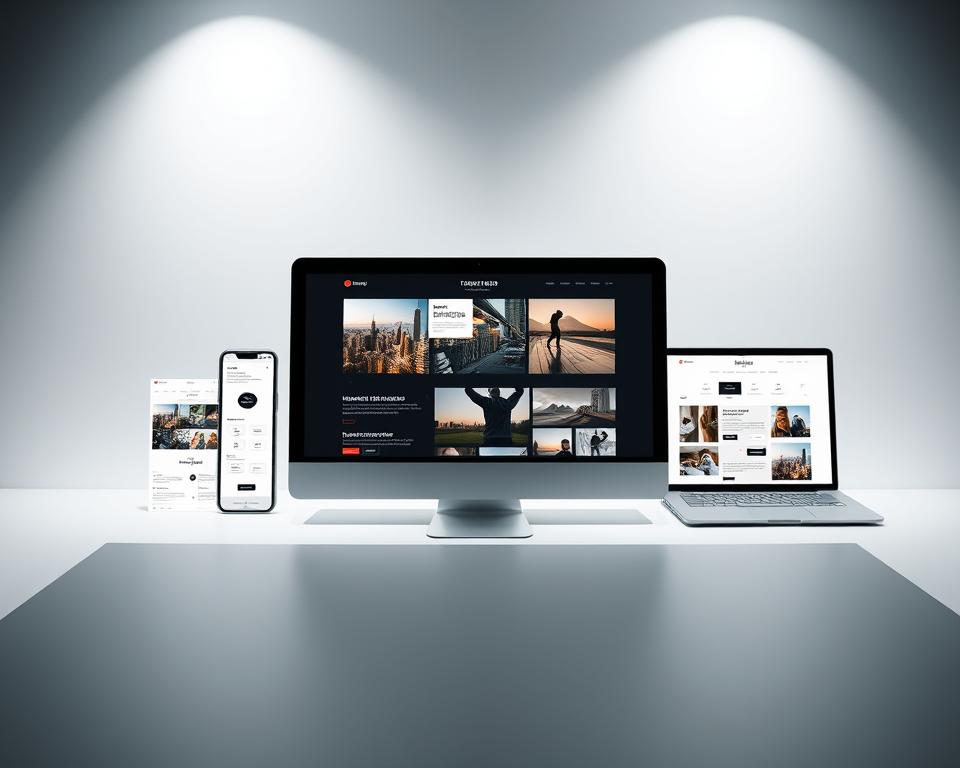Creating a website involves two main areas: web development and web design. Web development is about building and keeping websites running. This includes coding, testing, and making sure everything works smoothly. You might need help from a web development company for this.
Web design, however, is all about how a website looks and feels. It covers the layout, graphics, and how easy it is to use. Knowing the difference between these two is key.
It’s important to understand the difference if you want to work in either field. This way, you can focus on what you’re good at and get better at it. Web design is not just about coding; it’s also about making a website look good and easy to use.
Table of Contents
Key Takeaways
-
- Web development involves building and maintaining websites, including coding and testing.
- Web design focuses on the visual and user experience aspects of a website.
- Understanding the difference between web development and web design is essential for career development.
- Web development and web design require different skill sets and areas of expertise.
- The distinction between web development and web design is important for creating a successful website.
- Web development and web design are interconnected, but distinct fields.
- Knowing the difference between web development and web design can help individuals make informed decisions about their career paths.
The Fundamentals of Web Creation
Web creation is a complex process that includes web building and design. It’s key to making a website that works well and looks good. To start, you need to know the basics of web building, like HTML, CSS, and JavaScript. For more tips on building your own web portal, check out web creation tips.
The web creation process has many stages, from planning to launch. Knowing the basics helps you make a website that meets your needs. Important parts of web creation include:
- Responsive design, which makes your site look good on all devices
- Accessibility, so everyone can use your site
- User experience, how people interact with your site
These elements are key to a successful website. By focusing on web creation’s basics, you can make a standout site. Web building and design are crucial, and knowing their value can make your site unique.
Web creation is always changing, with new tech and tools coming out. It’s important to keep up with trends and best practices. By mastering web creation’s basics, you’ll be ready to create a successful and lasting website.
What is Web Design?
Web design is about making a website look good and work well. It involves the layout, graphics, and user interface. It also covers the website’s overall look and feel. A good website is easy to use and offers a great user experience.
Some key elements of web design include:
- Layout and graphics
- User interface design
- Navigation and information architecture
- Visual elements and principles
A well-designed website is easy to navigate. It provides a smooth user experience for visitors. Web designers use principles like balance and contrast to make websites look good and work well.
Good web design is key for any website. It can greatly impact the user experience. By focusing on user interface and aesthetics, designers can make websites that keep visitors coming back. This can help businesses succeed.
Core Components of Web Development
Web development is a complex field with several key parts. It involves making websites that work well and look good. This is done by combining front-end, back-end, and full-stack development.
Front-end development deals with the client-side of a website. It uses HTML, CSS, and JavaScript to design the interface and user experience. This part is very important because it affects how users interact with the site.
Key Areas of Web Development
- Front-end development: client-side development using HTML, CSS, and JavaScript
- Back-end development: server-side development using programming languages like Java, Python, and Ruby
- Full-stack development: working on both the front-end and back-end of the website
Knowing these core parts of web development helps us see how complex it is. Each part, whether front-end, back-end, or full-stack, is crucial for making a website.
As web development keeps changing, it’s key to keep up with new trends and tech. This way, developers can make websites that are not just pretty but also easy to use. This helps businesses succeed online.
Essential Tools and Technologies in Web Design
Web design uses many web design tools and technologies to make websites look good and work well. Adobe Photoshop and Illustrator are key for graphic design. Sketch and Figma are favorites for web design.
Other important tools include Bootstrap and Foundation for web development. Also, WordPress and Drupal are top choices for content management systems. These web design tools and technologies help designers make websites that are easy to use and meet client needs.
- Graphic design software: Adobe Photoshop, Illustrator
- Web design software: Sketch, Figma
- Web development frameworks: Bootstrap, Foundation
- Content management systems: WordPress, Drupal
Web designers also need to keep up with new technologies and trends. This ensures their websites stay competitive and effective. By using these essential tools and technologies, web designers can make top-notch websites that satisfy both clients and users.
| Tool/Technology | Description |
|---|---|
| Adobe Photoshop | Graphic design software |
| Sktch | Web design software |
| Bootstrap | Web development framework |
Web Development vs. Web Design: Understanding the Difference
Creating a website involves two main areas: web development and web design. Web development is about building a website from scratch. It uses programming languages and software development methods. Web design, however, focuses on the website’s look, including layout and user experience.
Technical Skills Comparison
Web development needs technical skills like programming and data structures. Web designers, on the other hand, use creative skills like graphic design and user experience. Here are some key skills for each:
- Web development: HTML, CSS, JavaScript, PHP, Ruby, Python
- Web design: Adobe Creative Suite, Sketch, Figma, UX design principles
Work Processes
Web development and web design have different work processes. Web development includes coding, testing, and deployment. Web design involves designing, prototyping, and testing. Knowing the difference is key for those considering a career in these fields.
In conclusion, web development and web design are unique fields. They require different skills and work processes. Understanding these differences helps individuals choose the right career path based on their interests and abilities.
The Creative Process in Web Design
The creative process in web design is complex and involves many stages. It’s key to know the parts that make up this process to build a website that works well and is easy to use. Web design is a big part of web development, and the creative process is where it starts.
Understanding UI Design
UI design is about making a website’s interface easy to use. It deals with the visual parts like buttons, menus, and how text looks. A good UI makes a big difference in how users feel about a website, helping them move around and interact easily.
Understanding UX Design
UX design is about making the user experience positive and engaging. It’s about knowing what the users need and designing the website to meet those needs. UX design is vital in web design because it makes sure the website is easy to use, accessible, and fun.
Some key things to think about in web design include:
- Visual elements and principles, such as color, typography, and composition
- UI and UX design, and how they work together to create a seamless user experience
- Web design trends and best practices, and how to apply them effectively
In conclusion, web design’s creative process is complex and involves many stages. From UI and UX design to visual elements and principles, understanding these parts helps web designers make websites that are effective and easy to use. This ensures the website meets the needs of its users.
| Web Design Component | Description |
|---|---|
| UI Design | Creating an intuitive and user-friendly interface |
| UX Design | Creating a positive and engaging user experience |
| Visual Elements and Principles | Designing the visual elements of a website, such as color, typography, and composition |
Programming Languages and Frameworks
In web development, programming languages and frameworks are key. They are the foundation of a website. Their choice affects the site’s performance and ease of use. Web development frameworks like React and Angular are for the front-end. Back-end frameworks include Ruby on Rails and Django.
Important programming languages include HTML, CSS, and JavaScript for the client-side. Java, Python, and Ruby are for the server-side. These languages make web pages dynamic and user-friendly. Frameworks are also vital, offering a structured way to build web apps.
Using programming languages and frameworks has many benefits. They improve code quality and make development faster. They also make websites scalable and easier to maintain. Plus, they help teams work better together.
In summary, programming languages and frameworks are crucial in web development. The right choice can make a web project successful. Developers can then create fast, scalable, and user-friendly websites.
How Web Designers and Developers Collaborate
Web designers and developers must work together to make a website successful. They plan, design, develop, and deploy the site. This teamwork is key to meeting client needs and staying on schedule and budget.
Web design and development are different but go hand in hand. Designers make the site look good, while developers make it work. Tools like Slack and Trello help them share ideas and keep the project moving.
- Project workflow: This is the order of tasks in making the website.
- Communication methods: These are how team members talk and share info.
- Handoff processes: These are how tasks move from one team member to another, like from design to development.
By following a clear plan, designers and developers can create a site that meets client goals. They need to understand both design and development and be good at working together.
Career Paths and Opportunities
Web development and web design have many career paths and opportunities. With more businesses needing online presence, jobs for web developers and designers are plentiful. Experts say web developers can be front-end, back-end, or full-stack. Web designers can be UI/UX, visual, or web designers.
Some key career paths include:
- Web development manager
- Web design manager
- Digital product manager
These jobs need both technical and management skills. They offer chances for growth and advancement. For those starting in front-end web development, front-end web development tools are a good place to begin.
In summary, web development and design have many career paths and opportunities. Knowing the different roles helps individuals choose their path. This way, they can take advantage of the many opportunities in web development and design.
Industry Trends and Future Outlook
The web development and design world is always changing. This change is driven by industry trends and a focus on innovation and new tech. Looking ahead, it’s clear that emerging technologies will shape the industry.
Experts say it’s key for web developers and designers to keep up with new tech. This includes things like artificial intelligence, blockchain, and the Internet of Things (IoT). These are changing how websites are made and kept up.
- Responsive design and mobile-first development
- Accessibility and user experience
- Security and data protection
By knowing these industry trends and future outlook, web pros can get ready for what’s next. For more on web design vs. web development, check outthis resource.
As the field keeps evolving, staying current with emerging technologies is vital. This way, web developers and designers can keep up and thrive in this fast-changing world.
Common Challenges and Solutions
Web development and design face many challenges. One big one is making sure websites work well on all browsers. This can be solved by using tools like Bootstrap and Foundation. Responsive design is also a challenge, as websites need to work on different devices and sizes.
To tackle these issues, developers and designers use best practices. They focus on mobile-first design and test websites with users. This makes sure websites are easy to use and fast to load. Some solutions include:
- Using design systems like Material Design and Bootstrap to ensure consistency and efficiency
- Implementing user testing and feedback mechanisms to identify and address usability issues
- Utilizing web development tools and technologies like HTML, CSS, and JavaScript to build responsive and interactive websites
By tackling these challenges, web developers and designers can make websites that are easy and fun to use. This helps businesses grow and succeed.
Web design and development are always changing. It’s key to keep up with new trends and tech to stay ahead. By using BUZZWORD solutions, businesses can make websites that meet their audience’s needs and achieve long-term success.
Best Practices for Both Fields
Web development and design need best practices for top-notch results. It’s key to stick to design standards and development guidelines. This ensures your work is consistent, reliable, and performs well.
Design Standards
Design standards, like design systems and style guides, keep a website looking the same. They make sure all parts, like fonts, colors, and layouts, match the brand’s look.
Development Guidelines
Development guidelines are crucial for a website’s reliability and performance. They help developers write clean, efficient code. This code is easy to keep up and update.
Quality Assurance
Quality assurance is a key part of web development and design. It checks the website to make sure it works right and meets the client’s needs. This includes testing for usability, performance, and security.
Some top tips for quality assurance are:
- Regularly test and debug the site
- Use automated testing tools to speed up the process
- Do user testing to make sure the site is easy to use and meets the client’s goals
By sticking to these best practices, web developers and designers can make high-quality websites. These websites meet their clients’ needs and offer a great user experience.
| Best Practice | Description |
|---|---|
| Design Standards | Maintaining consistency across a website through design systems and style guides |
| Development Guidelines | Ensuring reliability and performance through coding standards and testing protocols |
| Quality Assurance | Testing and debugging to ensure the website meets the client’s requirements and is free of errors |
Conclusion
In the world of digital creation, knowing the difference between web development and web design is key. Both fields need special skills and knowledge. Web development covers many tasks, like front-end and back-end coding, and full-stack work. Web design, however, focuses on how a website looks and feels to users.
Learning the basics of web creation helps people understand web development and design better. Keeping up with new trends and tech, like responsive web design services, is important. Working well together, developers and designers can make websites that impress and meet client needs.
In short, web development and web design are different areas that need different skills. By following best practices and keeping up with new tech, you can do great in these fields. Whether you’re into web development or design, knowing the basics and staying informed is key to success online.



















